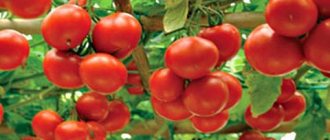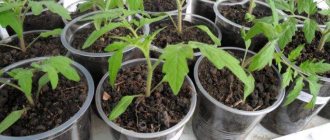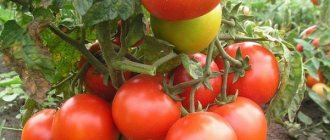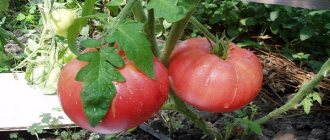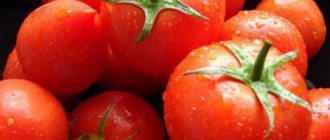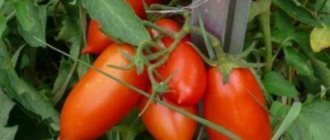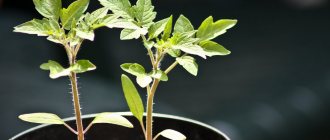MedovoeHobby.ru » Tomatoes » Tomato Don Juan - variety description
0
51
Article rating
The Don Juan tomato is considered one of the most popular and desired guests in the garden. It is valued for its taste and unpretentiousness. Gardeners call this variety “striped” because of the unusual two-color color of the fruit - the tomatoes are red with bright yellow stripes, they look quite decorative in the garden, in a salad, and in a jar (when canned).
Brief information about the variety
- Fruits and bush: determinate plant, medium-sized type, height up to 0.7 m, fruits weighing 100-120 g.
- Productivity: up to 6-8 kg/1 bush.
- Resistance: immunity to fusarium and verticellosis, heat-loving, not resistant to low temperatures.
- Distribution: the variety is cultivated everywhere, but in the northern regions it is planted only in greenhouses.
- Application: universal.
- Planting pattern: 0.4-0.5 m - between bushes, 0.5-0.7 m - between rows. The number of bushes is up to 4 per 1 m².
- Soil: loose, nutritious, neutral acidity.
- Care: classic, does not require mandatory pinching (carried out as needed), fertilizing up to 3 times during the growing season with an interval of 3-4 weeks.
- Ripening period: 90-95 days after emergence (approximately in July).
Tomatoes Diva on video
If you grew Primadonna tomatoes, please write what the yield and taste of the fruit were in your climatic conditions. How do you rate the disease resistance of this tomato? Briefly describe the advantages and disadvantages of this tomato in your opinion. If possible, attach a photo of the entire bush or individual fruits you grew to your comment. Thank you!
More than 1,500 varieties of tomatoes with photos, descriptions and reviews from gardeners in our Tomato Catalog. Enjoy watching.
Your reviews of the Primadonna tomato and additions to the description will help many gardeners evaluate this hybrid more objectively and decide whether it is worth planting or not.
Detailed characteristics
The Don Juan variety is most successfully grown in the southern regions (in the Middle Zone). When cultivated in northern regions, it requires planting in closed greenhouses.
Average yields are 6-8/1 bush, or up to 12-16 kg/1 m² when planting up to 5-6 plants.
External description
The bush is moderately leafy, determinate type, compact. The height when planted in open ground is up to 70 cm; when grown in closed greenhouse conditions, it can grow a little higher.
Vegetables on a fruit cluster - 5-7.
The weight of tomatoes is 100-120 g, sometimes reaching 250-350 g. The shape is round, slightly elongated in length. The peel is dense, without cracking. The color at the stage of consumer maturity is orange-red with yellow or green stripes. In the area where the stalk is attached there is ribbing, the number of seed chambers is from 6 to 8;
The structure of the pulp is fleshy.
Taste
Don Juan tomatoes have a classic sweetish taste with a characteristic sourness.
The main purpose is to eat fresh and for preparing first and second courses. Suitable for whole-fruit canning, can be used in the production of sauces and for other culinary processing.
Variety of early tomato varieties
Everyone who plants tomatoes hopes for a good harvest. But this is long and painstaking work. For those who want to grow their crops with high quality, we will offer early varieties of tomatoes.
For our territories, where farming always has certain risks, the early ripening of tomatoes is a great advantage. Therefore, ultra-early varieties of tomatoes, which begin to bear fruit a hundred days after planting, and early varieties of tomatoes are becoming more and more in demand from year to year.
Which early varieties are best grown in open ground?
Alpha
The first tomato variety suitable for open ground, which we will talk about, is called “Alpha”.
These early tomatoes begin to bear fruit 87-96 days after the plantings have sprouted.
This species is also suitable for adherents of the seedless growing method.
In addition, “Alpha” is suitable not only for open ground, it also feels great in greenhouse conditions. The length of the stems most often lies in the range of 40 - 50 cm.
“Alpha” fruits are medium in size, semicircular in shape, rich red in color, filled with juice, weighing about 50-70g each. These are best used fresh; they are not suitable for seaming.
Aphrodite F1
Another species grown in open ground conditions is “Aphrodite F1”; it represents hybrid ultra-early ripening varieties of tomatoes.
The fruits begin to appear within 75-80 days after planting. The bushes grow up to 70 cm, compacted. Tomato fruits are quite large, weighing 110 - 115 g.
The tomatoes are fleshy, round, and beautiful red in color. They can be stored for a long time, are almost not damaged during transportation, and are excellent for both fresh eating and seaming.
Amur standard
Next, it is worth remembering the “Amur Standard”. These early-ripening tomatoes are also great for open ground.
Just like the previous variety, “Amursky Stamb” can be grown from seeds without resorting to the use of seedlings.
Fruiting of these tomatoes begins 85-95 days after the first shoots. Plants do not need to be pinched.
Under normal conditions, bushes can reach 45-50 cm in height. The rounded fruits are much larger than those of “Alpha” - 120g, and are red in color.
This variety is characterized by high resistance to cold and ease of care.
Benito F1
The next variety that is suitable for open ground is super early tomatoes “Benito F1”.
This hybrid determinate variety produces fruits on the seventieth day after sowing. The bush grows low, up to half a meter. However, the fruits are large, weigh about 140 g and have an elongated shape.
The advantages of this tomato are its resistance to certain types of diseases, for example, fusarium.
Valentina
"Valentina" ripens a little later, after 95 - 98 days.
But the variety has a number of advantages over others. It tolerates drought well, as well as weather changes.
They are red, plum-shaped, and have thick skin. These early tomatoes are practically not susceptible to cracking, they contain a huge amount of ascorbic acid . The fruits have a universal purpose.
Gina
"Gina" bears its first fruits on the hundredth day. She, like many early tomato varieties, is determinate.
The height of the stem can reach 70 cm.
This variety must be cultivated.
“Gina” is good because it is resistant to fusarium, as well as some other diseases.
Explosion
The next variety is called "Explosion". Many have heard about “White Filling”, and so, “Explosion” is its derivative, an improved variety. These early-ripening tomatoes are also grown in open ground conditions. The plant turns out to be small, its maximum height is 45 cm, but spreading.
Stepping is necessary, but in moderation. The fruits are large, up to 150 g, round in shape. This species also has excellent cold hardiness. Practically not susceptible to late blight infection.
Don Juan
“Don Juan” is also great for open ground. The appearance of fruits usually occurs 90 - 100 days after the first shoots.
The tomato reaches a height of 70 cm. The fruits stand out for their unusual appearance. They are oblong and have a so-called spout. Pink colour. There are yellow stripes along the entire fruit. The weight of one tomato is approximately 70 g.
Due to its density, the fruits of this variety are easy to transport. They are great for seaming.
What early varieties are best to grow in a greenhouse?
Along with early varieties for open ground, there are many varieties of tomatoes that are good for growing in greenhouses.
golden brush
Among them is the “Golden Brush”. These are early tomatoes that begin to bear fruit 95-98 days after planting.
You need to take care of them carefully, timely trimming and tying up.
Despite being difficult to care for, these tomatoes are popular due to their incredibly tasty, dense fruits.
Mandarin duck
The next variety is called Mandarin. It is indeterminate and vigorous. It needs to be pinched and tied up.
At the end of the season, it is recommended to pinch the growing point of the stem. The fruits of this variety weigh up to 100g, grow in clusters of up to 10 tomatoes, and are orange in color.
“Tangerine” tolerates unfavorable conditions well; they have virtually no effect on the appearance of ovaries.
Sugar plum raspberry
Variety “Sugar plum raspberry”
The “Raspberry Sugar Plum” variety is famous for its small but very pleasant-tasting fruits.
It is suitable exclusively for greenhouses.
The fruits are plum-shaped, very sweet, dense and, as the name suggests, have a crimson color.
They can be eaten fresh or canned.
Greenhouse early ripening F1
Remembering the earliest varieties of tomatoes, one cannot help but mention “Greenhouse early ripening F1”.
It ripens in 90 days and forms large fruits, weighing 120 - 180 g. Plantings grow to a height of 70 cm.
The fruits have a round shape and the usual red color, universal in their purpose.
Poznan
The Poznan variety is also an early ripening variety and is excellent for greenhouses.
It is an indeterminate racemose, the bushes are tall, reaching 190-200 cm. They also need staking and pinching.
It is best to form them into one stem.
The fruits are large, up to 120g, orange and round in shape.
F1 President
The next variety is “President F1”. This is a hybrid.
It is unusual in its semi-determination. Bushes most often have a height of about 70 cm; they must be pinched.
The fruits of the “President F1” variety are very large, can reach 170g, have an almost ideal round shape and scarlet color.
Due to their increased density, they are stored for a long time and can be used for seaming.
Sweet bunch
It is also worth remembering the “Sweet Bunch” variety.
It begins to bear fruit 90 - 100 days after planting. These tomatoes grow very tall from 250 cm.
They are formed into two stems, tied, and stepsoned.
The fruits are small, weighing 10–20 g, but very sweet. Up to 50 tomatoes can grow on one brush.
This variety bears fruit for a long time and abundantly, even in very poor conditions.
Superstar
The “Superstar” variety, on the contrary, produces very large fruits, some of them weigh 250 g, and the average yield is 225 g.
The shape is round - flat and rich red in color. These tomatoes are very meaty, but nevertheless do not store very well. It is better to eat them fresh.
Advantages and disadvantages
| pros | Minuses |
|
|
Tomato variety Krasnobay f1
Numerous reviews about the Krasnobay F1 tomato are extremely positive. Resistant to typical diseases, it is enough to use preventive measures: compliance with the temperature regime and watering time (do not water the plant in the heat, this can burn the sprout), use of fertilizing. This variety is suitable only for experienced gardeners.
The fruits of Krasnobai are large, on average about 350 grams; there are specimens weighing up to five hundred grams. The tomatoes have a pleasant round shape and a characteristic red hue. They have high taste characteristics, are not used for canning (due to the excessively large size of the fruits), and are used in barrel pickles.
Krasnobay does not get along with other varieties of tomatoes, which is why it is worth planting this species separately. Krasnobay is late-ripening.
Germination of seeds
The preferred method of cultivation is through seedlings.
Sowing of seeds is planned 55-60 days before moving to a permanent place - in March-April.
Soil and seed preparation
Seed material is sown in a disinfected substrate.
For growing seedlings of the Don Juan tomato variety, a mixture of turf soil, peat, humus, sand and ash is suitable.
Before sowing, seeds should be soaked in warm water for 0.5 hours with the addition of a biogrowth stimulator, which increases the germination percentage. Next, they must be washed in running water and dried naturally, and then hardened in the refrigerator for a week, changing the temperature every 12 hours from 0°C to 20°C-22°C.
Sowing technology
Seeds are sown in 1-2 pieces, buried at a distance of 0.5-1 cm, sprinkled with earth on top and covered with polyethylene to create a greenhouse effect.
Care
Until the first shoots germinate, the containers are kept at a temperature of 22-24°C. When the seedlings appear (approximately 7 days after sowing), they are transferred to a cool place at 18-19°C, and the film cover is removed.
Watering is carried out by spraying from a spray bottle as the top layer of the substrate dries.
Picking
Seedlings need picking after growing 3-4 leaves. The seedlings are transplanted into individual containers, deepened by 5-7 cm, and placed in a well-lit place under diffused light.
The total required daylight hours are at least 12 hours.
Description of the Malvina tomato and characteristics of its taste
Early ripening varieties, for example, the Malvina tomato, are especially valuable because they suffer little disease. Moreover, they are suitable for growing in areas where the summer is quite short. These are very good tomatoes that are resistant to most diseases. The fruits of this variety have a universal purpose, and the yield with proper agricultural technology is consistently high.
Description of the variety
These tomatoes are known to many gardeners. They are loved because you can enjoy the delicious fruits within 85 days from the moment of sowing the seeds for seedlings. Ripening times may vary slightly depending on growing conditions. In open ground with a lot of sunny days, tomatoes will ripen earlier. The maximum ripening period for the Malvina variety is 100 days.
The description and characteristics of the variety indicate that this tomato produces fairly tall bushes. In greenhouse conditions they stretch up to 2 m, but in open beds - no more than 1.5 m. The Malvina variety is classified as determinant, so it has limited growth.
Considering that the tomatoes turn out to be tall, they must be tied up. Otherwise, the bush will simply fall from the wind or under the weight of the fruit. In this case, the gardener will not be able to obtain maximum yield.
For the Malvina variety, pinching is a prerequisite. Without removing excess branches, it will be difficult for the plant to develop properly and produce a large number of fruits. Experienced gardeners recommend forming bushes into 2 trunks. This way you can get the greatest number of fruits.
With the right agricultural technology, you can harvest 5 kg of tomatoes from each bush. These plants are not planted too close, as they are quite lush and can block each other’s sun. It is best to limit yourself to 3 bushes per 1 m². This way you can get the most tasty and healthy fruits.
Malvina should be planted only from seedlings. Seeds can be sown as early as March, if we are talking about a region with warm summers, where there is already enough warmth and sun in May. For those latitudes where the summer is short, you can sow the seeds in April to harvest in mid-summer.
For Malvina tomatoes, fertilizing and weeding with loosening play an important role. These mandatory procedures must not be forgotten under any circumstances, otherwise the yield will begin to fall.
In addition, you should water the plant carefully. It does not tolerate drought, but excessive humidity will be destructive for it. If the humidity level is more than 60, fungus will begin to appear on the tomato, and this threatens the loss of the entire crop.
Most often, the development of fungal diseases occurs when tomatoes are grown in a greenhouse. But you need to take into account that a similar problem is not excluded in open ground. Therefore, preventive measures should be observed, namely, spraying the plants, watering only at the roots and applying special fertilizers to strengthen the immunity of the tomato.
Fruit characteristics
One of the main features of this variety is its fruits. They are very small and look like the well-known cherry tomatoes. Tomatoes grow in clusters. Each produces 16 small fruits. They are small and round. These tomatoes look very good both in jars and in salads.
The average weight of 1 tomato is 20 g. They are very sweet, acid is almost completely absent. Tomatoes have thick skin and moderate meatiness. This makes them suitable for canning as a whole and for transportation over long distances.
Small tomatoes are good to marinate, salt and add to salads. But they also make excellent juices and sauces. With the right agricultural technology, the gardener will be able to harvest a sufficient harvest of tomatoes, so there will be enough of them for both fresh consumption and canning.
Transplanting seedlings
The best yield is obtained when grown in a greenhouse.
The seedlings are transplanted 60-65 days after seed germination, after the appearance of 5-6 or more leaves:
- in the southern regions - at the end of April-beginning of May (in a greenhouse) or in the last third of spring (in open ground);
- in the northern regions - at the end of May - beginning of June.
Conditions for open ground: the soil warms up to 10-15°C to a depth of about 10 cm, daytime ambient air readings are kept at 16-18°C, nighttime temperatures are not lower than 10°C.
The soil for planting should be nutritious and loose, with a high proportion of turf content, good moisture absorption and breathability, and neutral acidity.
The bed is prepared in advance: a mixture of humus (10 kg), superphosphate (30 g), wood ash (500 g) is added to each m².
Scheme:
- 8-10 days before transplanting, seedlings begin to harden, taking them to a cool place;
- holes are dug about 15 cm deep;
- the optimal distance between plants is 0.4-0.5 m, between rows - 0.5-0.7 m with an average quantity of up to 4 per 1 m².
- For 10-14 days from the moment of open planting, the sprouts are covered with a plastic cover to protect them from return frosts.
The transplanted seedlings are watered 1 liter under each bush and sprinkled with soil after the final absorption of water, the root zone is mulched.
Description of the Don Juan tomato, its characteristics and cultivation features
Fans of unusual tomato colors will definitely like the Don Juan tomato. Its uniqueness lies in the fact that the fruits are striped. Therefore, they look great in vegetable salads and in jars that were prepared for the winter.
The variety appeared quite a long time ago, and every year the number of fans of the Don Juan tomato grows. This is due not only to the unusual coloring, but also to the excellent taste and relative unpretentiousness of the plant.
Characteristics of the variety
Don Juan tomatoes, photos of which can be found below, are universal in terms of planting. They can be grown both in greenhouses and in open ground. In regions where summers are short and cold, it is worth growing Don Juan tomatoes in greenhouse conditions. In the south and central regions, this variety gives an excellent harvest when grown in soil.
An important characteristic of Don Juan tomatoes is the compactness of the bushes. The variety is classified as a determinant type, so you should not expect the plant to stretch up to 2 m. Most often, when grown in soil, bushes of 70 cm are obtained. In a greenhouse, Don Juan may be slightly taller, but not much.
This variety also has the advantage of early ripening. In this case, ripe fruits may appear as early as 3 months from the moment the seeds are planted. Separately, it is worth noting the yield of the variety. Don Juan is one of the record holders in this regard.
With proper care, you can harvest 8-10 kg of delicious tomatoes from a bush. However, it should be noted that a good harvest can only be obtained from healthy bushes. To prevent tomatoes from getting sick, they should be planted in the ground only with the onset of stable heat.
Description of the Don Juan fruit
These tomatoes have a lot of positive qualities. Some are attracted by the low growth of the bushes, others like the incredibly high yield, and still others choose these tomatoes for the unusual color of the fruit. The tomatoes look very interesting. There is no gardener who would be indifferent to this variety.
Description of fruits:
- While tomatoes are in the ripening stage, they are similar in appearance to small watermelons. Due to this, the beds look very original.
- When the fruits are fully ripe, they turn crimson and have yellow stripes. These tomatoes look interesting. Already at the stage of fruit formation, their unusual color becomes noticeable - light green, with dark stripes.
- The shape of Don Juan tomatoes is slightly elongated. They can be compared to a plum. It is worth noting that the official description given by the manufacturer indicates that tomatoes of this variety should have a characteristic spout. However, it does not appear in every case. Most often, tomatoes are smooth oval in shape.
- Don Juan tomatoes turn out to be small. They weigh on average 90 g, but there are also significantly larger fruits.
- The pulp is sweet, with a pronounced sourness. Tomatoes have thick skin.
All these characteristics indicate that tomatoes of this variety are excellent for canning for the winter, pickling and pickling.
Considering that the flesh of striped tomatoes is very juicy, they are often used to make salads. They also make excellent juice. High yields make it possible to obtain a huge amount of fruits, which will be enough for various dishes and preparations.
Features of cultivation
To grow the Don Juan variety, it is best to use seedlings. It is strong, so the plants take root well in a new place.
After the bushes begin to form, the standard work for this crop should be carried out. Stepchildren are removed from the bushes for better yield, tied up if necessary and watered thoroughly. If the summer is hot, watering is required daily. Mineral fertilizers should be applied 3 times per season. The soil should be loosened periodically to saturate the roots with oxygen.
Reviews about this variety of tomatoes are only positive.
Svetlana, Perm: “The tomatoes are small, but very beautiful. They are very suitable for winter canning. This year the harvest was especially rich, so it was possible to pickle, marinate, press juice, and even wither. This variety is suitable for everything.”
Elena, Pyatigorsk: “I took this variety for the first time. They grow like small watermelons. Very good tomatoes."
Ksenia, Tver: “Very original-looking tomatoes. They can be used both for salads and for winter preparations.”
Aftercare
Watering
Tomatoes are watered at the root, avoiding water getting on the foliage and stems. Consumption - 10 l/1 bush. Frequency: once every 14 days, depending on weather conditions. Watering is stopped 2-3 weeks before harvest.
Loosening
The root area is loosened. Loosening depth - up to 5 cm.
Feeding
| Deadlines | Type of feeding |
| When growing seedlings with obvious signs of nutritional deficiency | Agricola (diluted according to instructions), urea (1 tbsp per 10 liters of water) |
| Immediately at the time of planting in previously unfertilized soil | Humus. When dry, place it in the holes in a layer 10 cm thick, watering it with water afterwards. |
| 2 weeks before flowering begins | 1. Nitrogen-containing ready-made complexes. Use in dosage according to instructions. 2. Yeast.10 g/4 tbsp sugar/10 l water. The concentrate is diluted in a ratio of 1:10. 3. Urea or ammonium nitrate. Dosage - up to 30 g/10 l. The consumption rate is 1-1.5 liters of working fluid per bush. |
| After the formation of ovaries and at the stage of fruit formation | 1. Water with solutions based on ready-made fertilizers with phosphorus, potassium, boron and magnesium. Dilute according to instructions. The consumption rate is 1-1.5 liters of working fluid per bush. 2. Spray the foliage with boric acid (10 g) with wood ash (2 l) per 10 l of water. 3. Irrigate with potassium sulfate (40 g/10 l of water), superphosphate (1 tbsp/10 l of water). Working fluid consumption rate - 10 l/m² |
Formation
The Don Juan tomato is not formed. With the appearance of fruits, low-growing bushes are tied to supports.
Does not require mandatory stepsoning. It is carried out as needed. To ensure free passage of air flow and access to sunlight under the fruit clusters, all leaves are cut off.
A variety with an exotic appearance - Don Juan tomato: detailed description of tomatoes and characteristics
Don Juan tomatoes are an interesting two-color variety with fruits with thin stripes. Cute tomatoes look great in salads or in preserved jars, and thanks to their high yield, the harvested tomatoes are enough for any culinary experiment.
| Height | Landing location | Ripening time | Fruit color | Fruit size | Origin | Fruit shape |
| short | Greenhouse, Open ground | Early ripening | Bicolor | Average | Variety | Plum-shaped or oval |
Description and characteristics of the variety
The Don Juan tomato is a low-growing determinate plant that stops growing when it reaches 70 cm. The variety is early ripening - the first harvest appears 90-100 days after seed germination. The fruits are collected in clusters of 6-7 pieces. They are oval, plum-shaped, medium-sized, 80-100 grams. The skin is colored red, mottled with yellow stripes, which begin to appear even when the fruit is green. The pulp is juicy, tender, tastes sweet and sour. The variety is used for canning whole tomatoes, for salads, and for making juices, pastes, and sauces.
- great taste;
- interesting appearance;
- unpretentiousness;
- high productivity;
- resistance to diseases.
Minuses:
Features of cultivation and storage
You can grow tomatoes both in protected greenhouses and in the garden. They need tying so that the branches do not bend to the ground under their own weight. In addition, the bushes are pruned, removing excess shoots.
The harvested crop is well stored due to its thick skin.
Planting and care
Seeds are planted for seedlings in March if they plan to transfer them to a greenhouse, and a little later, depending on the climate, if they will be grown in open ground.
The seeds are buried 1 or 2 cm, carefully watered with a spoon or from a spray bottle and cover the containers with film. Before germination, the temperature is kept at +23-25, and after that it is reduced to +18 for a week. This measure prevents the bushes from stretching out to the detriment of development. Then the temperature is raised again to +23.
When the seedlings have 2 true leaves, they are planted in separate large pots so that the root system develops better.
Before transplanting to a permanent place, the seedlings should be hardened off by taking the boxes with them outside during the day. The period of exposure to air is increased every day, and at night the seedlings are kept indoors at a temperature of +10-15. After a week, the seedlings are ready.
Diseases and pests
Don Juan is resistant to fusarium and verticellosis. The average period of ripening of vegetables sometimes causes the development of late blight. Affected plants are dug up, healthy bushes are treated with fungicidal preparations.
The variety is at risk for the spread of gray rot, against which pinching and ventilation of closed greenhouses helps.
It is recommended to spray tomatoes against infections three times during the growing season.
More often, nightshades are affected by the Colorado potato beetle, aphids, and spider mites. Insecticidal treatments are used against harmful insects.
Errors during cultivation
The main mistakes that gardeners make when growing these wonderful stripes come down to the following:
- planting too early in insufficiently warmed soil, which can cause seedlings to wither and become sick;
- excessive watering, which creates a risk of developing gray rot and mold;
- high humidity in the greenhouse, which leads to the same problems;
- Insufficient quality of pinching, as a result of which the bush thickens.
Reviews from gardeners
As mentioned above, people who grew Don Juan tomatoes in their summer cottages generally speak positively about this variety, noting the attractive appearance of the fruit and excellent taste. In addition, gardeners like the fact that the variety is unpretentious in care and has a universal purpose: striped tomatoes can be used to prepare tomato juices, salads, and pastes. They can also be pickled, salted, or dried. Little children love the bright, watermelon-like fruits.
Summarizing:
Plant several bushes of this variety on your plot, and tomatoes of an unusual color will delight you with their appearance all season long. In the winter cold, striped tomatoes will lift your spirits when you open jars of winter preparations.

